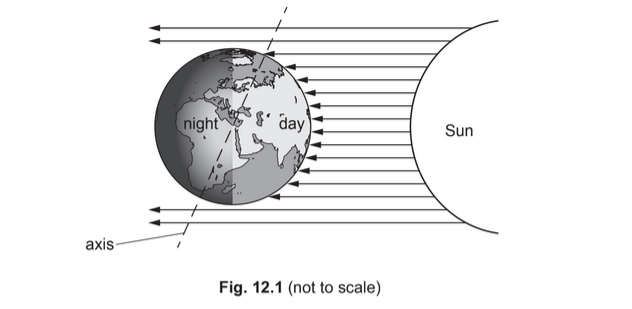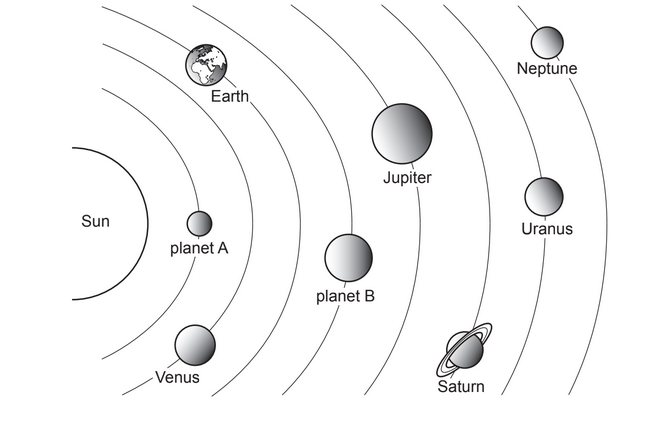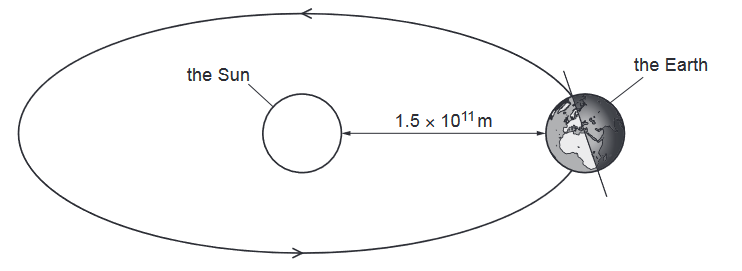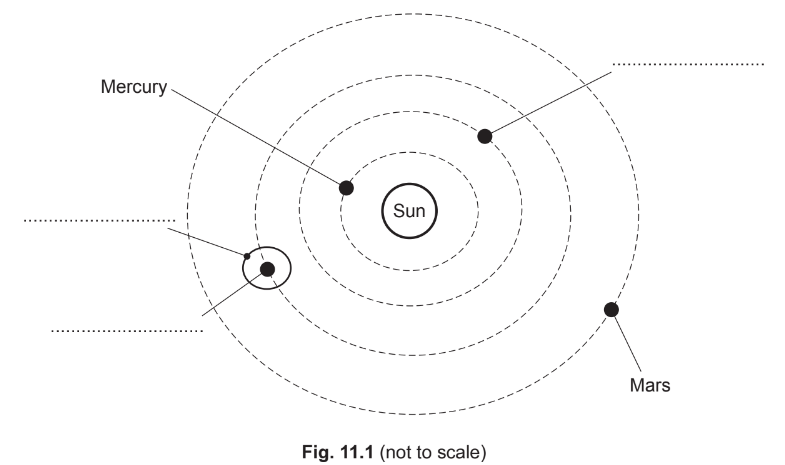Question
(a) Fig. 12.1 represents the Earth and the Sun at one point in the Earth’s orbit of the Sun.

Explain the apparent daily motion of the Sun across the sky.
…………………………………………………………………………………………………………………………………
…………………………………………………………………………………………………………………………………
…………………………………………………………………………………………………………………………… [2]
(b) List the four planets closest to the Sun in order of their distance from the Sun. One is done for
you.
1 ………………………. 2 ………………………. 3 ………Earth …….. 4 ………………………. [2]
(c) The Sun mostly consists of two elements.
State the two elements.
1 ………………………………………………………………………………………………………………………………
2 ……………………………………………………………………………………………………………………………… [2]
(d) The Sun is a star in a galaxy.
State the name of the galaxy.
…………………………………………………………………………………………………………………………… [1] [Total: 7]
▶️Answer/Explanation
Ans:
(a) Earth rotates / spins (on its axis)
(once) every 24 hours / day OR daily
(b) Mercury Venus Earth Mars
(c) hydrogen
helium
(d) Milky Way
Question
Fig. 10.1 represents part of the Solar System.

(a) (i) State the name of planet A and the name of planet B.
planet A ……………………………………………………………………………………………………………..
planet B …………………………………………………………………………………………………………….. [2]
(ii) On Fig. 10.1, draw an \(X\) to represent a moon of Jupiter. Draw a line to show how this moon moves.
(iii) State two ways in which the four planets nearest to the Sun are different from the four planets furthest away from the Sun.
(iv) Complete the following sentences:
The galaxy that includes the Solar System is called the……………………………..
The……………. includes billions of galaxies.[2]
(b) The distance between the Sun and the Earth is \(1.5 \times 10^{11} \mathrm{~m}\).
The speed of an electromagnetic wave is \(3.0 \times 10^8 \mathrm{~m} / \mathrm{s}\).
Calculate the time taken for an electromagnetic wave to travel from the Sun to the Earth.
time taken \(=\)\(s[3]\)
▶️Answer/Explanation
Ans:
(a)(i) Mercury (nearest to Sun)
Mars (between Earth and Jupiter)
(a)(ii) (circular / oval) path round Jupiter B1
(a)(iii) rocky OR furthest planets are gaseous owtte B1
small(er) OR furthest planets large(r) B1
(a)(iv) (the) Milky Way
(the) Universe
10(b) (time =) distance ÷ speed in any form
\(\begin{aligned} & 1.5 \times 10^{11} \div 3.0 \times 10^8 \\ & 500(\mathrm{~s})\end{aligned}\)
Question
Fig. 11.1 represents the Earth in orbit around the Sun.

(a) (i) State the name of the force that keeps the Earth in orbit around the Sun.
……………………………………………………………………………………………………………………. [1]
(ii) State the time taken by the Earth to complete one orbit of the Sun. Include the unit.
time for one orbit = ………………………………………………… [1]
(iii) State the time taken by the Earth to rotate once on its axis. Include the unit.
time for one rotation = ………………………………………………… [1]
(iv) The Sun consists mainly of two gases. State the names of the two gases.
……………………………………………………… and ……………………………………………………… [2]
(b) (i) Most of the radiation from the Sun consists of visible light and two other regions of the electromagnetic spectrum.
State the name of one of the other two regions. \([1]\)
(ii) The speed of visible light is \(3.0 \times 10^8 \mathrm{~m} / \mathrm{s}\).
Calculate the time taken for visible light to travel from the Sun to the Earth when the Earth is in the position shown in Fig. 11.1.
time taken \(=\)s [3]
▶️Answer/Explanation
Ans:
a)(i) gravitational (attraction)
(a)(ii) 365 (¼) days
(a)(iii) 24 hours
(a)(iv) helium
hydrogen
(b)(i) infrared OR ultraviolet
(b)(ii) 500 (s)
$1.5 \times 10^{11} /3.0 \times 10^8$
(time =) distance / speed
Question
There are eight planets in our Solar System.
Table 12.1 shows the names of some of the planets in order of distance from the Sun.
(a) Complete Table 12.1 by writing the names of the other planets in order of increasing distance from the Sun.\([2]\)
(b) The planets in Table 12.1 orbit the Sun.
State the names of two other types of natural object that orbit the Sun.
1…………………………………..
2………………………………….\([2]\)
(c) Complete the sentences to describe Mercury and Jupiter. Use words from the list.
large rocky gaseous small liquid
Mercury ………………is………………………and………………
Jupiter………………is………………………and……………… [2]
▶️Answer/Explanation
Ans:
(a) at least 4 named
all 5 in correct order
(b) any two from:
minor / dwarf planets / Pluto
asteroids
comets
moons / natural satellites
(c) Mercury is rocky AND small. (answers maybe in either order)
Jupiter is gaseous AND large. (answers maybe in either order)
Question
(a) State, in order, the names of the three planets closest to the Sun.
Closest to the Sun
Furthest from the Sun \([2]\)
(b) Define a light-year. [2]
(c) Jupiter is \(780000000000 \mathrm{~m}\left(7.8 \times 10^{11} \mathrm{~m}\right)\) from the Sun.
The speed of light is \(300000000 \mathrm{~m} / \mathrm{s}\left(3.0 \times 10^8 \mathrm{~m} / \mathrm{s}\right)\).
Calculate the time for light to travel from the Sun to Jupiter.
$
\text { time }=
$
[Total: 6]
▶️Answer/Explanation
Ans:
(closest to Sun) Mercury
Venus
(furthest from Sun) Earth
(b) distance
travelled by light (in the vacuum of space) in one year
(c) $
2.6 \times 10^3(\mathrm{~s}) \text { OR } 2600(\mathrm{~s})
$
time \(=\) distance \(\div\) speed OR \(7.8 \times 10^{11} \div 3.0 \times 10^8\)
OR \(780000000000 \div 300000000\)
Question
Fig. 11.1 represents the Sun and part of the Solar System.

(a) Complete the labels on Fig. 11.1 by writing on the dotted lines. [3]
(b) Complete the sentences about the Sun.
The Sun consists mostly of the elements ………………………………………………………………. and
………………………………………………………………. .
Most of the Sun’s energy is radiated in the infrared, ………………………………………………………..
and ………………………………………………………………. regions of the electromagnetic spectrum. [4]
(c) Give an estimate for the diameter of the Milky Way galaxy.
diameter = ………………………………… light-years [1] [Total: 8]
▶️Answer/Explanation
Ans:

11(b) Hydrogen and
Helium (answers maybe in either order)
visible (light) and
Ultraviolet (answers maybe in either order)
11(c) 100 000 (light-years)
